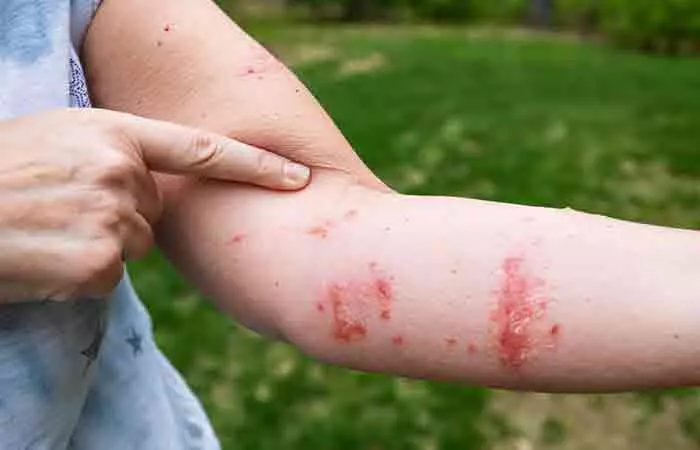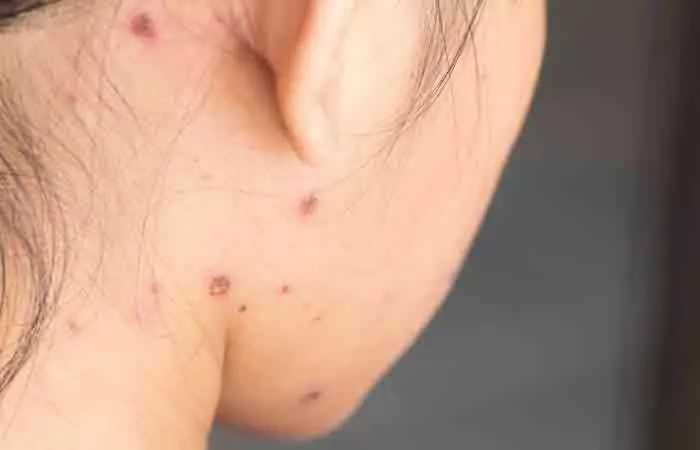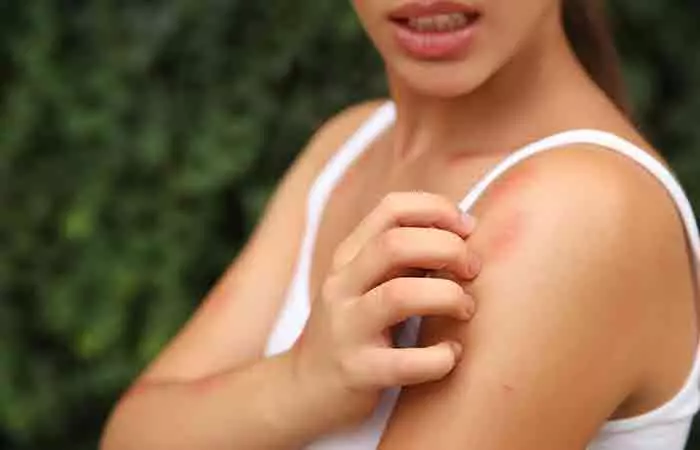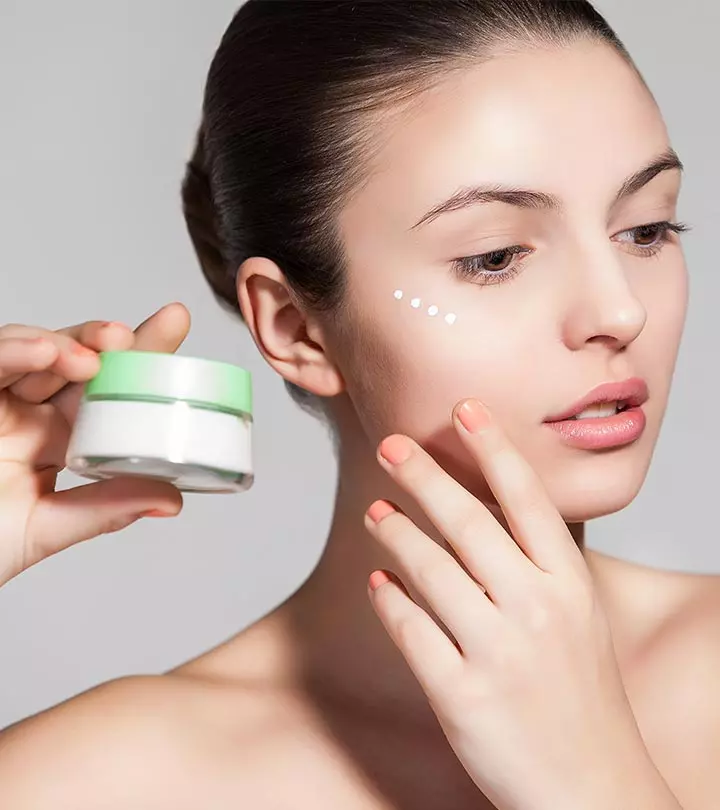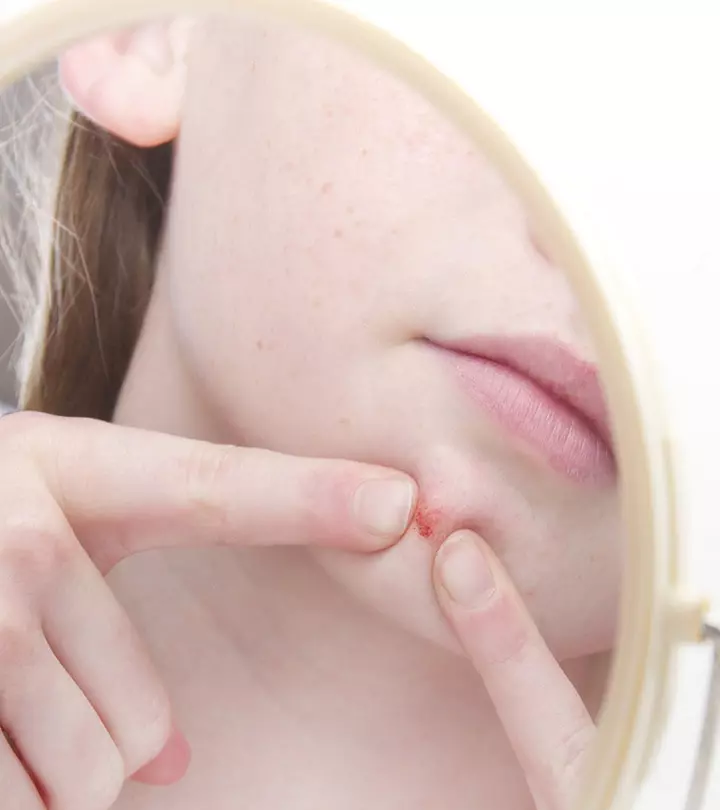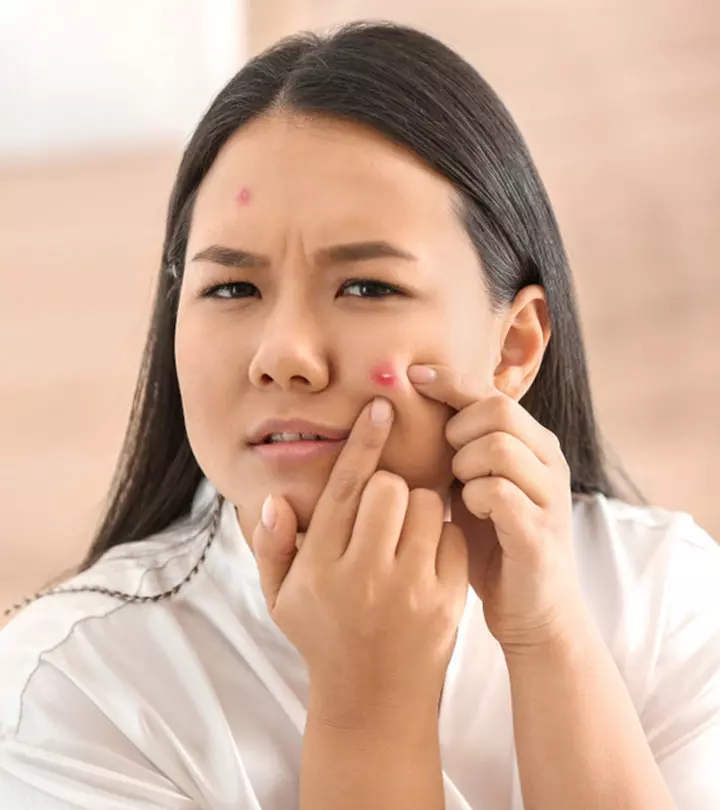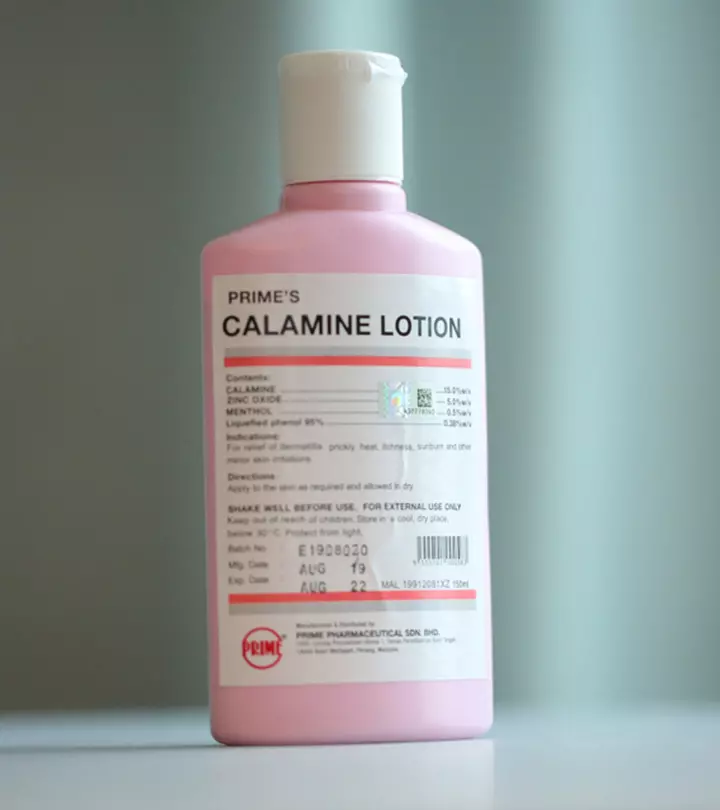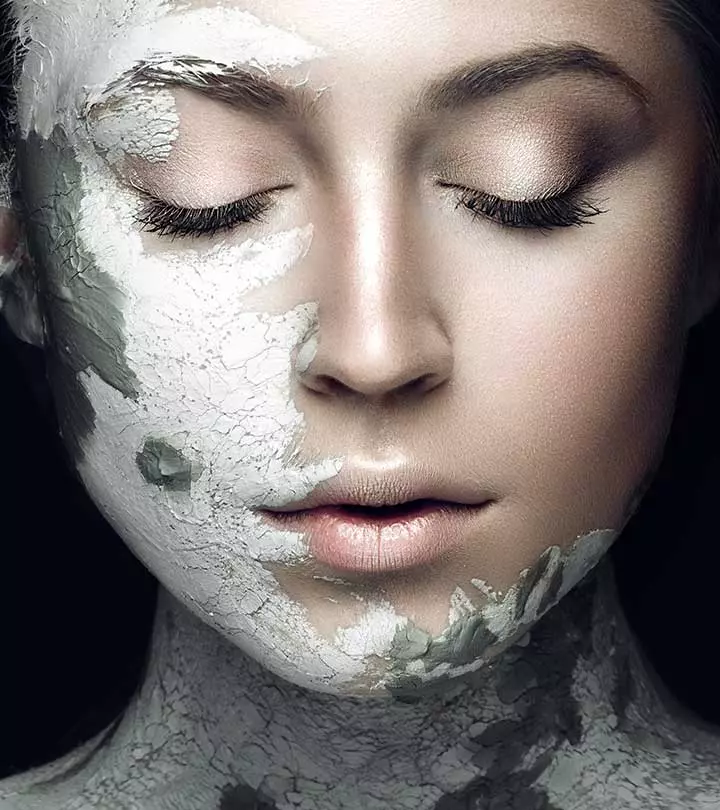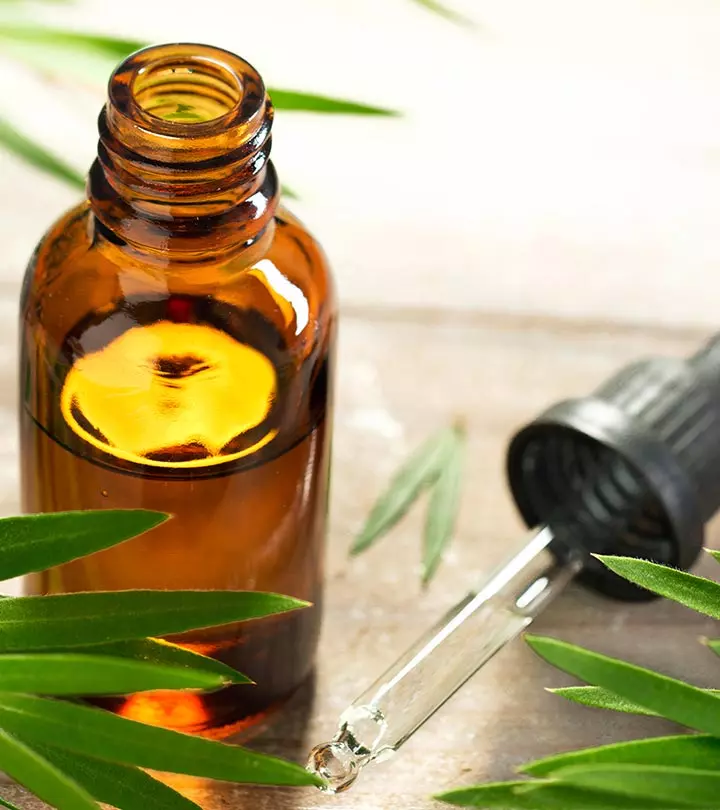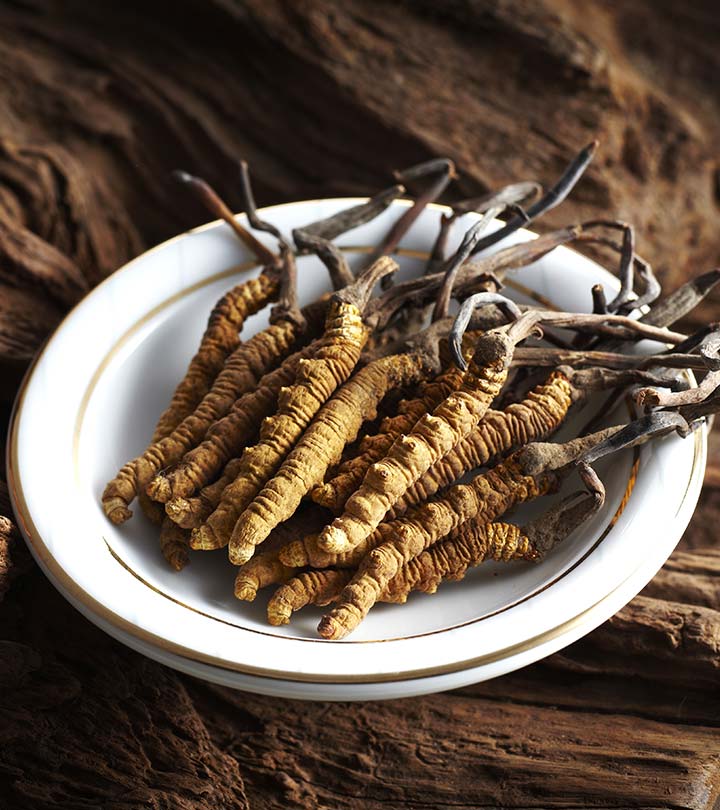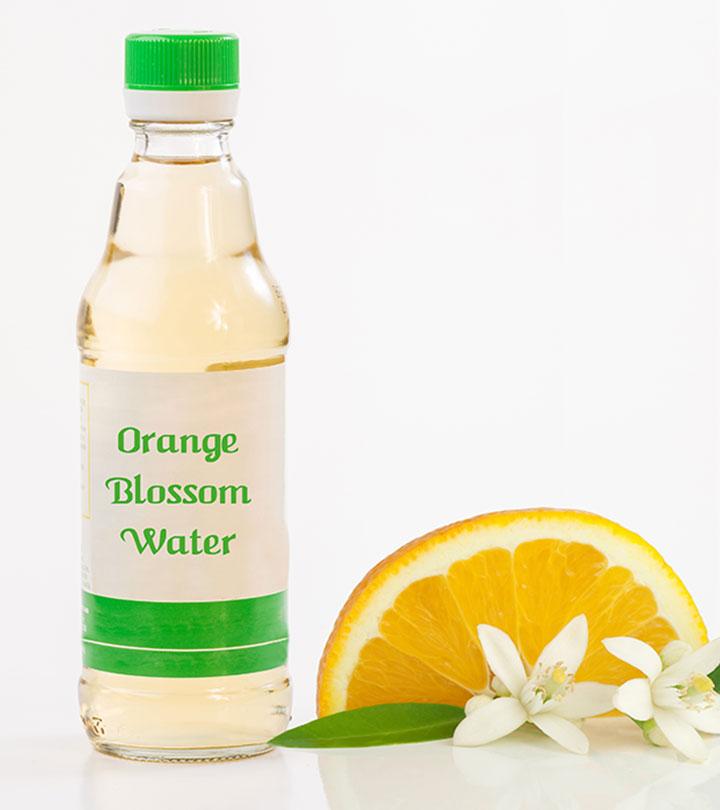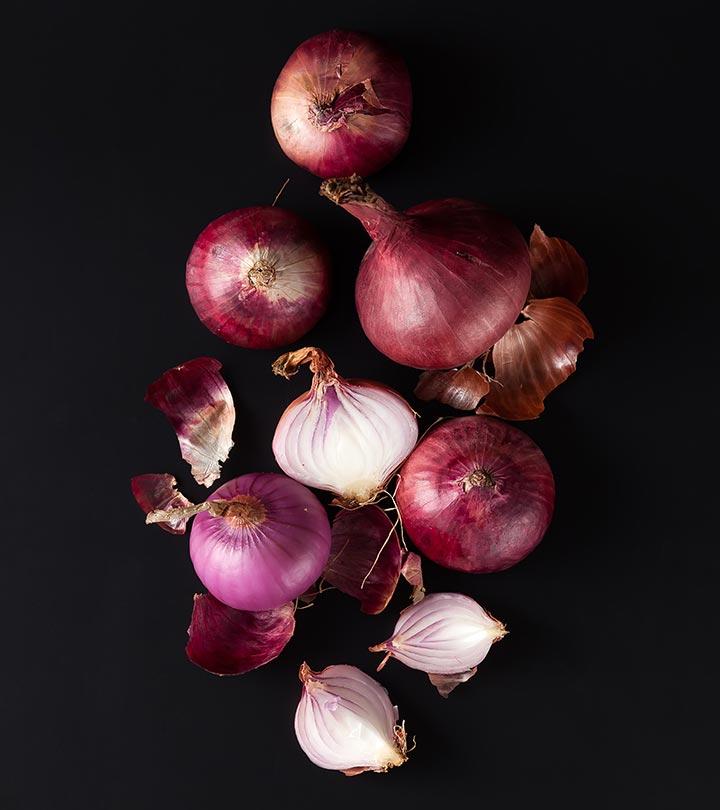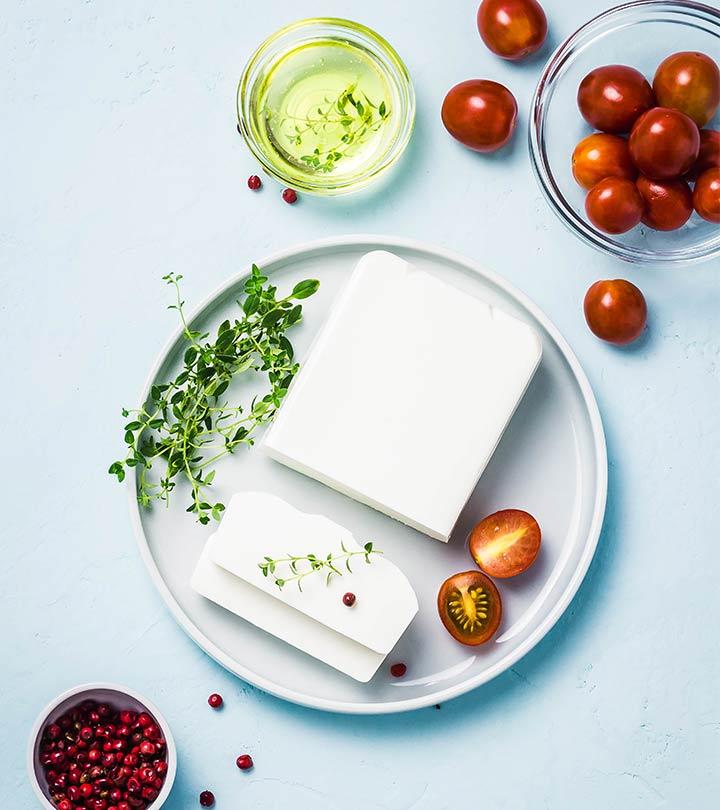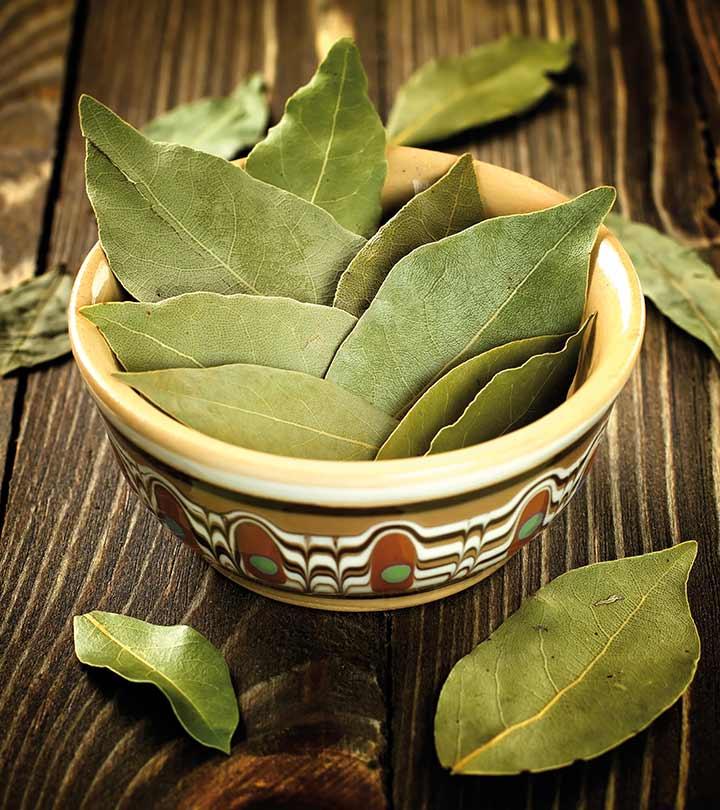11 Amazing Benefits Of Calamine Lotion – How To Use It The Right Way
Bid farewell to various skin issues with this incredible and moisturizing lotion!
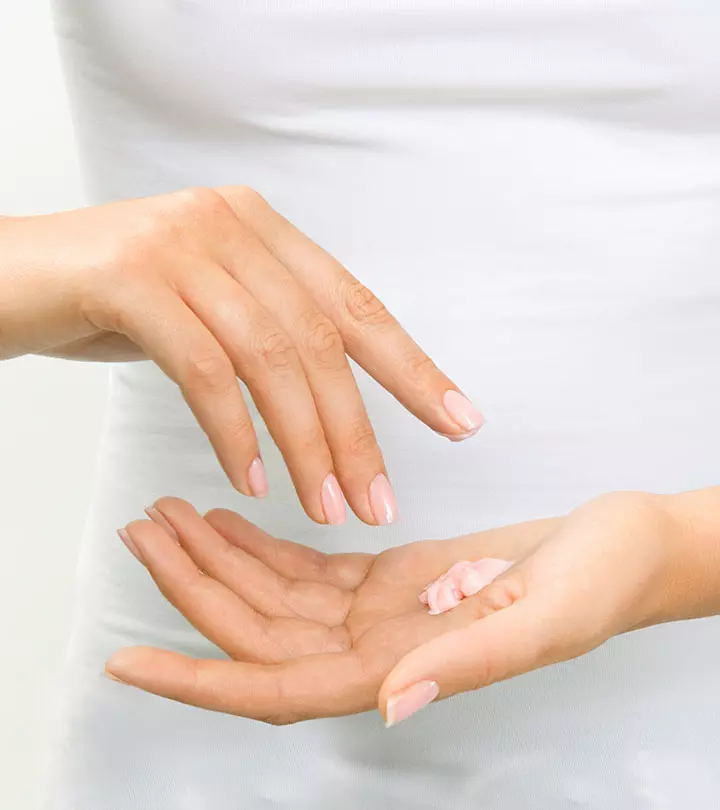
Image: Shutterstock
From treating sunburns, itchiness, and skin infections to wounds, Lacto calamine’s benefits are immense. It is a mix of ferric oxide and zinc oxide supported by other important ingredients such as calcium hydroxide and phenol. This lotion has featured on the Model List of Essential Medicines (21st edition) released by the WHO (World Health Organization) (1).
Calamine lotion is cheap, effective, safe, and easy to use. However, the latest studies suggest that it may not effectively treat severe infections like shingles, chickenpox, etc. (2).This article discusses all these aspects in detail besides explaining how to use this lotion safely and the potential risks to be wary of. Keep reading.
 Know Your Ingredient: Calamine Lotion
Know Your Ingredient: Calamine LotionWhat Is It?
A topical ointment that can be used to soothe the skin and treat skin problems.
What Are Its Benefits?
May help manage acne, treat diaper rashes in infants, and relieve itching.
Who Can Use It?
It is safe to use for both adults and children. However, some people might be allergic to the inactive ingredients in the lotion.
How Often?
Simply apply to the affected area as much as prescribed.
Caution
Avoid using it on open wounds or anywhere near the eyes, nose, or genital areas.
In This Article
What Is Calamine Lotion? How Does It Work?
Calamine lotion is a topical drug formulation that treats itching and irritation. It helps reduce insect bites and plant (e.g., poison ivy/oak) allergies (3), (4).
This lotion has a base of zinc oxide and iron oxide that gives it a reddish-pink tint. These minerals, particularly zinc, provide great relief from itching (pruritus) (5), (6).
Zinc oxide has anti-inflammatory and astringent properties, which further add to the benefits of calamine lotion.
 Quick Tip
Quick TipWhat Are The Benefits Of Calamine Lotion?
Calamine lotion contains zinc, which is crucial for the maintenance and functioning of the skin. It may aid in relieving skin irritation, plant allergies, and infections.
1. May Treat Plant (Poison Ivy/Oak) Allergy
The rash caused by poison ivy, poison sumac, and poison oak is an allergic reaction to their sap. The clear or pale yellow sap escapes from damaged areas of the dead or alive plant and gets absorbed into your skin almost immediately (7), (8).
The affected areas start itching and turn red, swollen, and blistered. In severe cases, patients develop oozing or weeping sores (7).
To manage the rash, wash the affected area with cold water and soap within 30 minutes of contact. Cover the blisters with generous amounts of calamine lotion. The zinc oxide in this lotion relieves local inflammation, dryness, itching, and soreness (6), (7), (8).
If the infection persists and gets severe, your doctor can prescribe a stronger topical cream or oral steroids.
2. May Help Manage Acne
Studies have shown that topical and oral supplementation of zinc reduces the symptoms of acne vulgaris. Topical zinc could reduce the growth of Propionibacterium acnes strains due to its sebum-reducing and anti-inflammatory effects (6).
Calamine lotion is a zinc-rich formulation. It controls the production of histamines, compounds that flare inflammation. In a 2010 study, subjects who were treated with oral antibiotics in combination with calamine showed satisfactory results (9).
However, there is no evidence that shows a direct positive effect of calamine on acne (6).
A blogger tried calamine lotion as a remedy for acne and shared her experience in her blog. She writes, “Using calamine lotion regularly, redness was reducing, and pimples were shrinking. Overall, this helped dry out all of my existing pimples, and anything that was going to come up eventually (i).
3. May Heal Chickenpox Symptoms
Most of the treatment for chickenpox focuses on relieving the itching of the pox blisters and preventing broken blisters (as a result of scratching) from getting infected (11).
Cool baths with uncooked oatmeal followed by topical application of calamine lotion can help reduce the itching and dryness (10), (11).
However, no studies have evaluated the effect of lacto calamine lotion for itching relief from rashes associated with chickenpox (2).
4. Treats Diaper Rashes In Babies
This lotion has proven to soothe skin irritation and mild rashes. It is thus added to creams or ointments that are applied to diaper rashes in babies and infants. Calamine works by keeping the skin free of moisture and protects chafed and sensitive skin (12).
Change wet and soiled diapers promptly. Clean the diaper area and allow it to dry. Apply calamine lotion or cream liberally and as often as necessary with each diaper change. Follow this routine, especially at bedtime and when the diaper has been on for an extended period (12).
Some infants have sensitive skin or other underlying skin conditions. It is recommended that you consult a pediatrician before applying calamine or any medication on the baby. Also, if the rash persists even after a week, report it to the doctor (12).
5. Helps Manage Insect Bites, Hives, And Scabies
Working with bees, aphids, and bugs involve frequent insect bites that may lead to hives, scabies, and infection. Applying ice packs and calamine lotion can be an immediate solution to relieve itching and inflammation (13), (14).
Calamine may also offer temporary relief from spider bites. Scabies and stings/bites from fleas, mites, and chiggers can also be managed by applying it topically. But if pain, swelling, and redness persist, consult a healthcare provider (13), (15), (16).
6. May Provide Relief From Sunburns
Sunburns are often accompanied by acute itching and redness. Applying calamine lotion can relieve these primary symptoms. It may also moisturize and soothe the affected dry areas as it has skin hydration properties (8).
However, if the small blisters break, apply an antibiotic cream and not a moisturizing lotion like calamine. In case the rash gets worse, seek medical help (17).
7. Relieves Itching During Pregnancy
Around 1-8% of pregnant women experience uncontrollable itching in specific areas of their body, which may worsen at night. Hormonal changes may cause acute pruritus (itching). These changes may also impact pre-existing skin diseases or cause new pregnancy-induced skin conditions (18), (19).
Ideally, patients should be on bed-rest and a low-fat diet. Topical medications like calamine lotion, cooling agents, and emollients can be given under medical guidance. Any oral medication may have a direct effect on the newborn or the fetus, so only mild antihistamine drugs or steroids may be administered. They should only be given to augment the topical medication (18), (19).
8. May Help Manage Eczema And Psoriasis
The zinc oxide in calamine lotion plays a critical role in managing eczema or atopic dermatitis, seborrheic dermatitis, and psoriasis. It is a potent anti-inflammatory agent that manages itching, dryness, and irritation caused by these skin conditions. Applying this lotion at bedtime has shown positive effects on itching (6), (20), (21).
Topically applied zinc oxide formulations also have intense antioxidant and antibacterial effects. They may restore the skin barrier function, lower free radical damage, and eliminate bacterial colonies in the affected areas (6).
However, there are no scientific trials that establish the direct effect of calamine lotion on psoriasis and eczema.
9. May Reduce Viral Warts And Shingles
Viruses cause most of warts you see on your skin and around nails. These viruses usually include human Papilloma Virus(HPV), Herpes Simplex Virus (HSV), Herpes Zoster, and Human Immunodeficiency Virus (HIV). Depending on the type of virus, warts can appear on your hands, feet, back, face, or genitals (6), (22).
The zinc derivatives in calamine formulation may eradicate warts and shingles, according to recent studies. Though research has not proven the action of calamine lotion in these cases yet, it is commonly used as a general relief medication (6), (22).
It is safe to consult your doctor before using any medication, especially if your genitals are affected.
10. May Lower Fungal Infection Symptoms
Fungal pathogens often cause skin infections characterized by itching. Athlete’s foot, jock itch, ringworm, Candida intertrigoi A skin rash that occurs in the groin or the folds of the skin from an infection caused by the yeast Candida. It causes inflammation. , toenail fungal infection, and carbunclesi Formation of a cluster of painful, pus-filled boils due to bacterial infection under the skin when it infects hair follicles. are a few examples of such infections (23).
Soothing creams like calamine lotion or emollients can be applied to the infected area under medical supervision. Most fungal and yeast infections lead to secondary infections, especially when they are not treated completely (24).
Your healthcare provider may prescribe stronger oral and topical antifungal medication in such cases.
11. May Accelerate Wound And Ulcer Healing
The mineral zinc is vital for wound healing. It is critical for skin regeneration. Studies show that topical supplementation of zinc oxide is more effective than the oral regimen. Zinc oxide formulations have antiseptic properties that can heal diabetic foot ulcers, burns, wounds, and blisters (6), (25).
They also have antimicrobial properties and, thus, prevent microbial infection of open wounds. Therefore, calamine and insoluble zinc oxide have been listed as mild antiseptics, astringents, and protective agents in superficial wound care(25).
 Quick Tip
Quick TipWith all these benefits, calamine lotion can be considered as a first-aid staple. Here’s how you use it.
How To Apply Calamine Lotion Safely
Note: Calamine lotion is for external use only. Do not swallow it. Do not use it on the eyes or on inside the mouth, nose, genital, or anal areas. Please proceed with medical consent only. Do not self-medicate.
- Before using, shake the bottle of calamine lotion well.
- Moisten a sterile cotton pad with the lotion.
- Gently dab the cotton pad on the affected area(s).
- Allow the lotion to dry on the skin. It may turn pale pink.
- If you are using calamine ointment, apply enough product to cover the affected area(s) and rub in gently.
- Close the lid and store the bottle away from your clothes. Calamine lotion can stain fabric when it dries.
- Store the medicine container at room temperature, away from heat, moisture, and direct light.
- Keep out of the reach of children.
Note: Wash your hands before and after using calamine. Put on hand gloves and a nose mask if you are working on large, infected, and oozing areas.
Is calamine entirely safe for topical use? Can it be used on adults as well as children? Check out the next section for answers.
What Are The Side Effects Of Calamine Lotion?
There are almost no proven adverse effects associated with the (excess) use of calamine lotion (3).
But, in rare cases, you may experience:
- Irritation
- Swelling around the calamine-treated area
- Hives on the tongue, throat, or face
If such symptoms persist, stop using calamine lotion immediately. Consult a healthcare provider, report your observations, and try an alternative medication (3). Also, if you have an existing skin condition, like rosacea, talk to a doctor before using calamine lotion as it may worsen the symptoms.
Moreover, there is insufficient information about the safety of calamine for pregnant and nursing women and children/infants. Seek medical help before using it.
These are some potential side effects of calamine lotion. But you can minimize these adverse effects by keeping some points in mind while using it. Scroll down to know more.
Precautions To Keep In Mind While Using Calamine Lotion
- Calamine lotion is for external use only. Do not ingest or swallow it.
- Avoid contact with nostrils, eyes, or mouth. If it occurs, rinse thoroughly with water.
- Do not apply calamine lotion on open wounds or broken skin, as it might cause irritation.
- Before applying it to a larger area of skin, perform a patch test to check for skin sensitivities.
- Always read the manufacturer’s instructions on the label and follow all application results for better results.
Do not keep it in the freezer, rather store it at room temperature, away from direct sunlight and heat.
Infographic: Common Uses Of Calamine Lotion
Calamine is an extremely effective treatment option for sunburns and itching. This is because it contains zinc oxide which has anti-inflammatory and itch-soothing properties. But there is so much more Calamine lotion can do for your skin.
Check out the infographic given below to know what are the most common Lacto Calamine lotion uses: Illustration: StyleCraze Design Team
Lacto Calamine lotion’s benefits are numerous. The lotion is a mixture of ferric oxide, zinc oxide, calcium hydroxide, and phenol. This lotion is topically applied to relieve plant allergy, acne, chickenpox symptoms, diaper rash, insect bites, hives, scabies, and sunburns. Calamine lotion can also help treat skin itching during pregnancy, eczema, psoriasis, shinglesi A painful skin rash caused by the chickenpox virus. People who have had chickenpox may develop shingles. , viral warts, and fungal infection symptoms. It also accelerates wound and ulcer healing. However, this lotion may trigger irritation, swelling, and hives in some people. Though this could be rare, caution is advised. Should these side effects persist, consult your healthcare provider without delay.
Frequently Asked Questions
Does calamine lotion brighten skin?
Dr. Anna Chacon, a double board-certified dermatologist and a Fellow of the American Academy of Dermatology, says, “The kaolin clay in calamine lotion offers skin-lightening qualities. It helps to balance out your skin tone and enhance the general texture of your skin.”
Can calamine remove pimples?
According to Dr. Chacon, “Calamine lotion helps speed up the healing of a single pimple or minor rash by drying it out.”
Can you put calamine lotion on your armpit?
Dr. Anna Chacon states, “One significant advantage of applying calamine on the skin daily is that it reverses the indications of aging on the skin. Calamine lotion, when used regularly, can help prevent the formation of fine lines and wrinkles on the face. In addition, it helps to revitalize your skin and aids in creating collagen in the body, which results in the regeneration of new cells under the skin.”
Is calamine lotion a sunscreen?
Dr. Chacon states, “Calamine products, with their cooling effect and soothing characteristics, can help relieve your skin. Calamine lotion also contains zinc oxide, which can help prevent sunburn. Zinc oxide protects against the sun by blocking UV radiation and is found in a variety of sunscreens.”
Can calamine lotion remove dark spots?
Possibly. Anecdotal evidence suggests that repeated application of calamine lotion may help lighten dark spots. However, the results are not significant.
Can you sleep with calamine lotion on?
Yes. You can apply calamine lotion overnight to soothe your skin and manage acne. But when it comes to sensitive skin, it is best to avoid keeping it on for a long time.
Is calamine lotion good for wrinkles?
While anecdotal evidence suggests that calamine lotion may help reduce fine lines and wrinkles, scientific studies on this matter are still lacking.
Key Takeaways
- Calamine lotion is a topical drug consisting of zinc oxide and iron oxide.
- Calamine lotion may treat skin irritations like poison ivy, sunburns, and insect bites.
- Zinc oxide in the lotion may help manage acne.
- Calamine lotion has a cooling effect which relieves itching and discomfort.
- It may help reduce itchiness during pregnancy.
References
Articles on StyleCraze are backed by verified information from peer-reviewed and academic research papers, reputed organizations, research institutions, and medical associations to ensure accuracy and relevance. Read our editorial policy to learn more.
- World Health Organization Model List of Essential Medicines, World Health Organization.
https://iris.who.int/bitstream/handle/10665/325771/WHO-MVP-EMP-IAU-2019.06-eng.pdf - Does the use of calamine or antihistamine provide symptomatic relief from pruritus in children with varicella zoster infection?, Archives of Disease in Childhood, US National Library of Medicine, National Institutes of Health.
https://www.ncbi.nlm.nih.gov/pmc/articles/PMC2082986/ - Calamine (Topical Route), Drugs and Supplements, Mayo Clinic, Mayo Foundation for Medical Education and Research.
https://kcms-prod-mcorg.mayo.edu/drugs-supplements/calamine-topical-route/proper-use/drg-20062463?p=1 - Calamine lotion to reduce skin irritation in children with cast immobilisation., Journal of Orthopedic Surgery, US National Library of Medicine, National Institutes of Health.
https://www.ncbi.nlm.nih.gov/pubmed/24014789 - Calamine, Compound Summary, PubChem, National Center for Biotechnology Information, US National Library of Medicine, National Institutes of Health.
https://pubchem.ncbi.nlm.nih.gov/compound/calamine#section=Related-Compounds-with-Annotation - Zinc therapy in dermatology: A Review, Dermatology Research and Practice, US National Library of Medicine, National Institutes of Health.
https://www.ncbi.nlm.nih.gov/pmc/articles/PMC4120804/ - Skin Care, University Health Services, Princeton University, American College Health Association
https://uhs.princeton.edu/health-resources/skin-care - Summer Staple – Zinc Oxide, Center for Research on Ingredient Safety, Michigan State University.
https://www.canr.msu.edu/news/summer-staple-zinc-oxide - Oral Antibiotics in Acne Vulgaris: Therapeutic Response Over 5 Years, Malaysian Family Physician, US National Library of Medicine, National Institutes of Health.
https://www.ncbi.nlm.nih.gov/pmc/articles/PMC4170416/ - Chicken pox (Varicella), Centers for Disease Control and Prevention, U.S. Department of Health & Human Services.
https://www.cdc.gov/chickenpox/treatment/?CDC_AAref_Val=https://www.cdc.gov/chickenpox/about/prevention-treatment.html - Chickenpox (Varicella), Harvard Health Publishing, Harvard Medical School.
https://www.health.harvard.edu/a_to_z/chickenpox-varicella-a-to-z - BABY ANTI MONKEY BUTT DIAPER RASH- zinc oxide, calamine cream, DAILYMED, US National Library of Medicine, National Institutes of Health.
https://dailymed.nlm.nih.gov/dailymed/drugInfo.cfm?setid=e4424d74-f89c-5943-42e8-bf3a38e68619 - Skin Health in Agricultural Workers, Washington State Department of Labor and Industries.
https://citeseerx.ist.psu.edu/viewdoc/download?doi=10.1.1.204.5470&&rep=rep1&&type=pdf - An approach to the patient with urticaria, Clinical & Experimental Immunology, US National Library of Medicine, National Institutes of Health.
https://www.ncbi.nlm.nih.gov/pmc/articles/PMC2492902/ - Insect Bites, StatPearls [Internet], Bookshelf, NCBI, US National Library of Medicine, National Institutes of Health.
https://www.ncbi.nlm.nih.gov/books/NBK537235/ - Scabies, Harvard Health Publishing, Harvard Medical School.
https://www.health.harvard.edu/a_to_z/scabies-a-to-z - Sunburn, First aid, Mayo Clinic, Mayo Foundation for Medical Education and Research.
https://kcms-prod-mcorg.mayo.edu/first-aid/first-aid-sunburn/basics/art-20056643 - Pregnancy and Skin, Journal of Obstetrics and Gynecology in India, US National Library of Medicine, National Institutes of Health.
https://www.ncbi.nlm.nih.gov/pmc/articles/PMC3444563/ - The Effect of Peppermint Oil on Symptomatic Treatment of Pruritus in Pregnant Women, Iranian Journal of Pharmaceutical Research, US National Library of Medicine, National Institutes of Health.
https://www.ncbi.nlm.nih.gov/pmc/articles/PMC3813175/ - Exacerbation of Skin Lesions in a 50 year old Man with Psoriasis during Treatment by Pegylated Interferon, Middle East Journal of Digestive Diseases, US National Library of Medicine, National Institutes of Health.
https://www.ncbi.nlm.nih.gov/pmc/articles/PMC4017695/ - Eczema or Atopic Dermatitis, ECZEMA, Student Affairs, The Pennsylvania State University
https://studentaffairs.psu.edu/health-wellness/medical-services/health-information-resources/eczema - Treating Shingles, Shingles (Herpes Zoster), Centers for Disease Control and Prevention, U.S. Department of Health & Human Services.
https://www.cdc.gov/shingles/about/?CDC_AAref_Val=https://www.cdc.gov/shingles/about/treatment.html - Infection, Pain, and Itch, Neuroscience Bulletin, US National Library of Medicine, National Institutes of Health.
https://www.ncbi.nlm.nih.gov/pmc/articles/PMC5799131/ - Skin conditions common to people with HIV infection or AIDS., AIDS Action, US National Library of Medicine, National Institutes of Health.
https://www.ncbi.nlm.nih.gov/pubmed/12342834 - Zinc in wound healing: Theoretical, experimental, and clinical aspects, Wound Repair and Regeneration, Academia.
https://www.academia.edu/31381905/Zinc_in_wound_healing_Theoretical_experimental_and_clinical_aspects
Read full bio of Dr. Jeanny Kim
- Dr. Anna Chacon, MD, FAAD, is a double board-certified dermatologist with over 7 years of experience. She has authored many peer-reviewed articles and managed clinical research studies during her fellowship. She completed her medical school in the PLME (Program of Liberal Medical Education) at Brown University.
 Dr. Anna Chacon, MD, FAAD, is a double board-certified dermatologist with over 7 years of experience. She has authored many peer-reviewed articles and managed clinical research studies during her fellowship. She completed her medical school in the PLME (Program of Liberal Medical Education) at Brown University.
Dr. Anna Chacon, MD, FAAD, is a double board-certified dermatologist with over 7 years of experience. She has authored many peer-reviewed articles and managed clinical research studies during her fellowship. She completed her medical school in the PLME (Program of Liberal Medical Education) at Brown University.
Read full bio of Arshiya Syeda
Read full bio of Aparna Mallampalli






